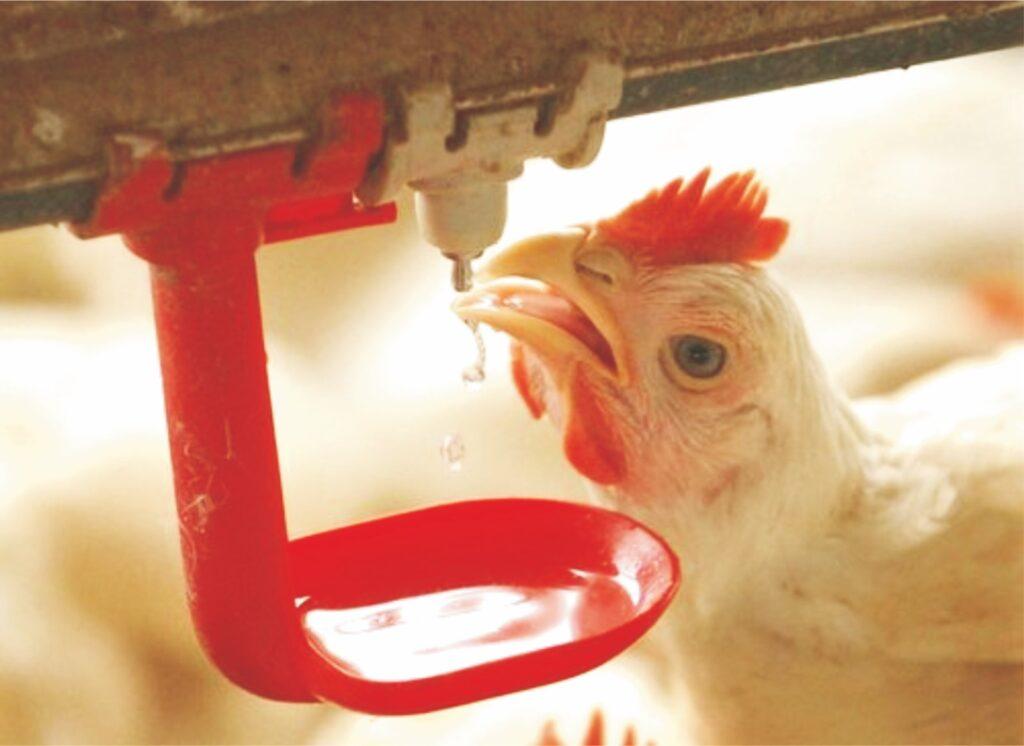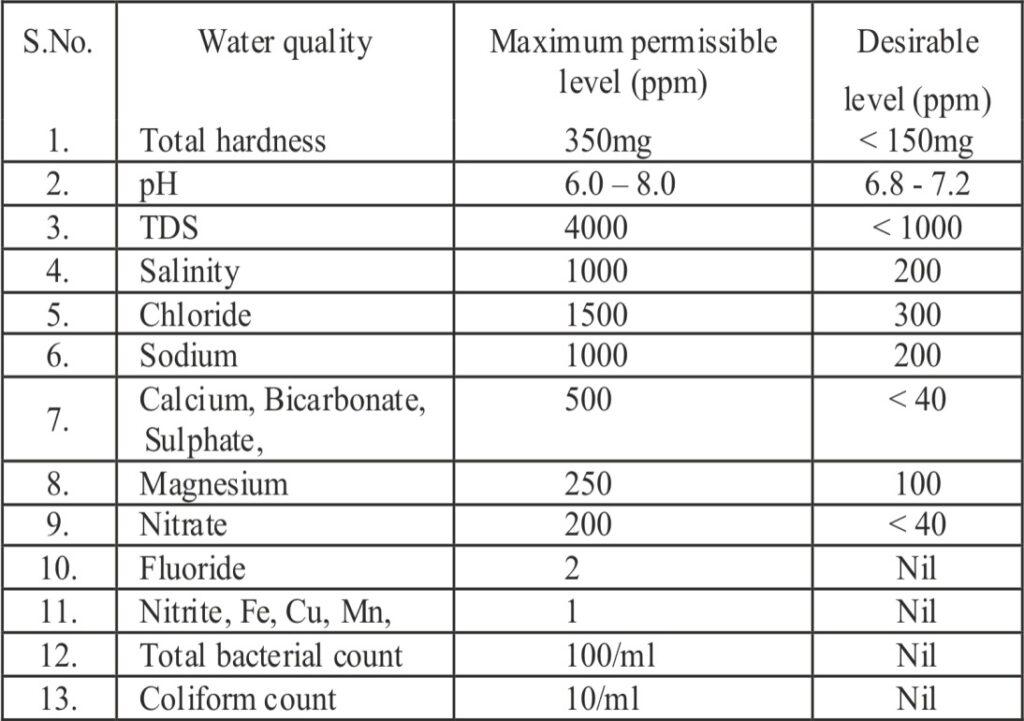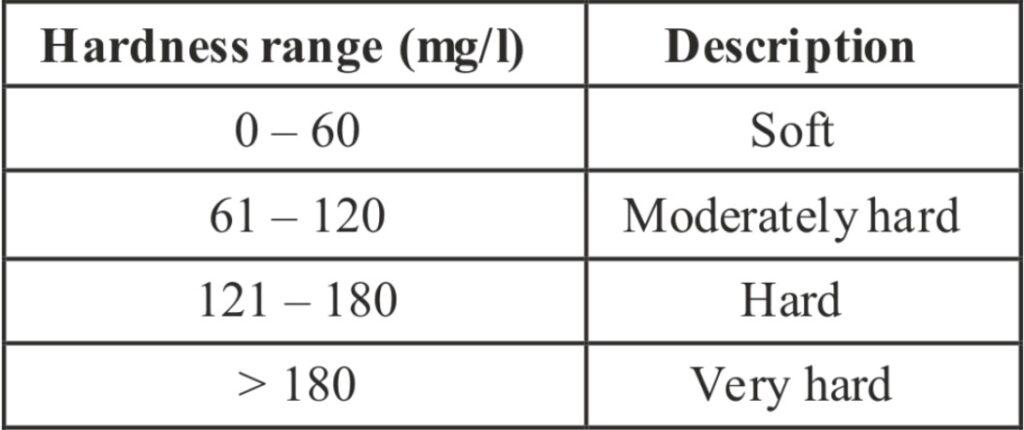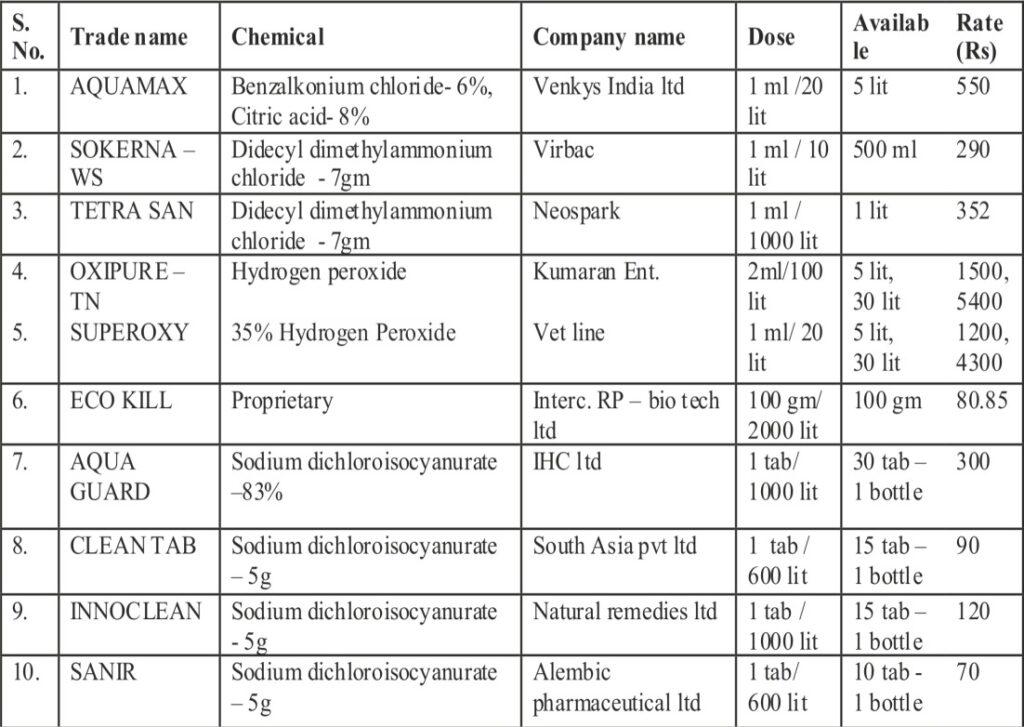Abstract
Water is a critical nutrient that receives little attention until a problem arises and it needed for bird consumption, reducing air temperature and facility sanitation. The desirable quality guidelines of water should be followed in poultry farm, to prevent further complications in birds. Water contamination starts from origin of source, while transport and during storage and it is impossible to judge adequately except with laboratory testing. Several sanitation methods are adopted in poultry farms; thereby providing safe drinking water to the birds, the farmer is not only minimizing the water born infections to the birds but also reducing the cost of medication.

Introduction
Water is a critical nutrient that receives little attention until a problem arises. Not only should producers make an effort to provide water in adequate quantity, they should also know what is in the water that will be flowing through the water lines to be used in evaporative cooling systems and consumed by the birds. Water is needed for bird consumption, reducing air temperature and sanitation. Broilers consume approximately 1.6 to 2.0 times more water than feed on weight basis. When water looks clear appearance and normal tastes, water quality is easy to take for granted. However, water quality is impossible to judge adequately except with laboratory testing. Field experience has conclusively shown that unobservable differences in water quality, from farm to farm and even from one well to another within a complex, can result in significant differences in bird performance.
Qualities of Water
Water contamination starts from origin of source, while transport and during storage. Further contamination occurs due to defective pipe lines, waterers and unhygienic practice during watering of birds. Therefore the ideal qualities of water are,
- It should be clear, tasteless, odourless, and colourless.
- Water should be pumped from either hardness free bore well or open well.
- Water should be clean and wholesome potable.
- Water should be free from foreign body such as faecal material.
- Water should be free from smell and colour.
- Water should contain minimal microbial load.
- Water should be free from pollutants from industries / effluent plant.
Hardness
Hardness refers to the presence of dissolved minerals such as calcium and magnesium in either bicarbonate or sulphate form and is expressed as an equivalent of calcium carbonate. It measures the tendency of water to precipitate soap and form scale. Hard water is commonly associated with the build-up of deposits and the formation of scale in the components of the watering system.
Table.1. The desirable quality guidelines for drinking water in poultry

Table.2. Water hardness has been classified as follows

Hardness is not commonly harmful to poultry unless certain ions are present in toxic amounts. High levels of magnesium sulphate (MgSO4) may cause an increase in water consumption, wet droppings, and a drop in production. When hard water is a problem in proper equipment operation, it can easily be ‘softened’ with commercial water treatment equipment. Most of the processes exchange the sodium ion from sodium chloride for other minerals present. It is recommended that the sodium of softened water be monitored because it may influence the amounts of fish meal, defluorinated phosphate, bakery products or salt used.
pH
Low pH water can be unpalatable, corrosive to equipment, and may have a negative impact on performance. High pH water is also unacceptable since it reflects high levels of calcium and magnesium, which can clog watering systems. Poultry accept water on the acid side better than they accept water on the alkaline side.
Total Dissolved Solids
Measurement of total dissolved solids (TDS) or salinity indicates levels of inorganic ions dissolved in water. Calcium, magnesium and sodium salts are the primary components that contribute to TDS. High levels of TDS are the most commonly found contaminants responsible for causing harmful effects in poultry production.
Water contaminants
Three major types of contaminants are minerals, micro organisms and organic matter including pesticide residues.
A wide variety of minerals are commonly found in drinking water. Normally, they are found in relatively low concentrations and cause no harm (Table 1). During summer season when the water level in the well goes down, the mineral concentration in the well water is rises up. High concentrates of sulphates can combine with magnesium to form Epsom salt or with sodium salts that cause a laxative effect and can result in wet litter. High concentrations of sodium or chloride may also increase water consumption and increase litter moisture. High levels of sulphate may also interfere with the intestinal absorption of other minerals such as copper.
High levels of magnesium are only a problem in the presence of high sulphate levels since they combine to form Epsom salt. The formation of scale in the watering system can be attributed to high levels of or combinations of sulphate, magnesium, or calcium. High levels of iron may encourage the growth of bacteria, which can lead to diarrhoea. When the ferrous form of iron present in well water is exposed to the air, it is converted to the ferric hydroxide form commonly referred to as rusty water.
On the other hand, during monsoon the mineral concentration is invariably lower due to raised water level and dilution with water. At the same time, the microbial load and organic contaminants in the water shoots up due to rain and flood water.
Faecal contamination of water will exhibit the presence of coliform organisms, nitrates, nitrites and ammonia. Presence of organic matter and bacterial contamination even alter the chemical composition of the drinking water, resulting in change of pH, increasing the phosphate content and form hydrogen sulphide, it results in failure of medication and vaccination.
Sanitizing drinking water
Successful water sanitation begins with a thorough water line cleaning program. The variability and dynamics of water systems create cleaning challenges, but these can be overcome with water quality information, a little effort and the right tools.
Water systems can become contaminated either from groundwater sources or from the environment in the barn. It is possible for coliform bacteria to enter a well due to poor construction, shallowness of the well or abandoned wells in the area. However, the barn environment is by far the biggest threat for bacterial contamination. Coliform bacteria are easily conveyed to the waterers by the birds during their daily activities.
There are a number of ways to control bacteria by chlorination, ozone, UV light, oxygenation, and hydrogen peroxide. However, only chlorine has a well-documented biocidal residue. Chlorine residual is the chlorine that stays active in the system to insure continual sanitation. Without residual chlorine, disease-causing bacteria are free to recontaminate the water system through the natural activity of the birds in the barn.
Chlorination or filtration of the water supply can eliminate bacterial contaminants. For a properly sealed and located well, treatment of the well cavity with a chlorine source such as sodium hypochlorite may remedy the problems. Between two and five ppm of residual chlorine is recommended. Start at the lower concentration and increase it until control is satisfactory. Chlorine not only kills bacteria, but is an oxidizing agent causes minerals such as iron and manganese to combine with oxygen, in the process coming out of solution and forming a solid precipitant. Chlorination also prevents other kinds of bacterial contamination, and may be needed even if iron and iron bacteria are not present in the water supply.
Sources:
- Bleaching powder (35% chlorine) – dosage 5g / 1000 lit. A minimum contact period of 60 minutes should be given, before offering the water to birds. But overnight contact time is preferable.
- 50% hydrogen peroxide dosage 1ml / 50 lit. of water is cheap and better alternative to chlorine for water sanitation. It also needs shorter period of contact time.
- Use of an iodine-base disinfectant to control bacteria in drinking water is effective and provides more residual activity, but is usually more expensive than chlorination.
- Iodophor compounds (1.6% iodine) dosage 1ml / 10 lit. of water, which provide 1.6 ppm of available Iodine.
- Quaternary Ammonium Compounds (QAC) dosage 1ml / 10 lit. It is also an algaecide; thus protect the pipe lines from blocking due to algal growth.
Be sure to use only approved chemicals at the recommended rates and ensure that the chemicals are compatible with watering equipment. Also, be sure to remove the disinfectant from the waterers and water lines before using a water vaccine or medication that is incompatible with the disinfectant. Continues usage of single sanitizers may develop resistant strains of microbes, so combination of chemicals should be used.
Recently new generation water sanitizers, containing bromine with noble metals as stabilizer, has been introduced. Since they are costlier, it can be used in case of development of resistant strains. Dosage 1ml / 30 lit. In farms where bacteria have developed resistance to various sanitizers, glacial acetic acid at the rate of 1ml / 5 lit. can be used.
Removal of Nitrogen compounds
Nitrate is a very soluble substance, easily dissolved in water and extremely hard to remove. Treatment for nitrate is therefore very complicated and expensive. The three methods of reducing or removing nitrate are demineralization by distillation or reverse osmosis, ion exchange and blending.
Demineralization removes nitrate and all other minerals from the water. Distillation is one of the oldest and most effective types of demineralization.
The distilling process has only three steps, such as
- The water is boiled;
- The resulting steam is caught; and
- The steam is condensed on a cold surface, turning back into water. The nitrate and other minerals remain concentrated in the boiling tank.
Reverse osmosis is another way to de-mineralize water. It reduces but does not remove all nitrates. Both of these demineralization systems require a lot of energy to operate efficiently and are high-maintenance systems.
Ion exchange introduces another substance that trades places with the nitrate. Most often chloride is exchanged for nitrate. The ion exchange unit is a tank filled with special resin beads that are charged with chloride. As water containing nitrate flows through the tank, the resin takes up nitrate in exchange for chloride. In time, all the chloride will be exchanged for nitrate. The resin can then be recharged by back washing with a brine solution (sodium chloride) and reused. Because ion exchange systems can treat large volumes of water, they are more appropriate than demineralization for treatment of livestock water supplies. There are some drawbacks to ion exchange systems. First, in addition to exchanging nitrate, the resin beads will also take up sulphate in exchange for chloride.
Therefore, if sulphates are present in the water supply, the capacity of the resin to take up nitrate is reduced. Second, the resin may also make the water corrosive. For this reason, the water must go through a neutralizing system after going through the ion exchange unit. Finally, backwash brines, which are high in nitrate, must be disposed of properly so they do not re-contaminate the groundwater supply. The third and most common way to reduce nitrates is to dilute the nitrate polluted water by blending it with water from another source that has low nitrate concentrations. Blending the two waters produces water that is low in nitrate concentration.
Cleaning of water tanks and water pipelines
This is essential to supply safe drinking water to the birds. Always cover the water tanks, with an air tight lid to avoid access to wild birds and rodents. In hot weather, cover the tank with coconut leaves or straw to avoid heating of water. Similarly cover the pipelines by burying in the soil and avoid exposure to direct sun light. Thorough cleaning and disinfection of the water tanks and flush the pipelines once in a month or at least during the downtime is essential.
Conclusion
Providing safe drinking water to the birds, the farmer is not only minimizing the water born infections to the birds; but also reducing the cost of medication, increasing the life of
pipelines and storage tanks, improving the overall performance of the birds and ultimately obtained higher net farm returns.
Table 3. Common Poultry Sanitizers available in the Market

References: References are available on request.